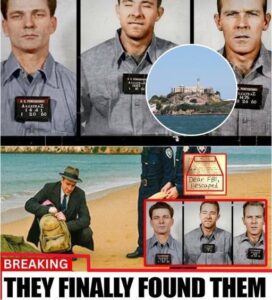The Untold Truth About the Great Alcatraz Escape

In June 1962, Alcatraz—the fortress-like island prison long labeled “inescapable”—was shaken by the most famous jailbreak in U.S. history. Three inmates, Frank Morris along with brothers John and Clarence Anglin, slipped past guards, dismantled security measures, and vanished into the freezing waters of San Francisco Bay. What became of them afterward remains one of America’s most enduring mysteries.
The Master Plan
Frank Morris, highly intelligent and notorious for past escape attempts, had been transferred to Alcatraz after slipping out of other prisons. The Anglin brothers, raised in Florida and accustomed to battling strong river currents, soon became his partners. Together, they devised a detailed plan over many months.
Using sharpened spoons and crude homemade drills, they quietly chipped away at the concrete walls of their cells. They drowned out the noise with music and disguised their progress by covering the holes with painted cardboard. Behind the cells, they created a secret workshop in an unused corridor, where they stitched life vests and built a raft out of prison-issued raincoats.
Their most brilliant touch was the lifelike dummy heads—made from soap, plaster, and real hair taken from the prison barbershop—which they left in their beds. Guards making night rounds were fooled into thinking the men were sound asleep.
The Great Escape
On the evening of June 11, 1962, the plan went into motion. Slipping through the widened air vents, the men scaled a utility shaft, reached the roof, climbed down, and made their way to the shoreline. Launching their homemade raft, they disappeared into the icy black waters of the bay.
By morning, guards were in shock. The prison went into lockdown as the FBI and Coast Guard swarmed the area. Helicopters, boats, and search teams scoured every corner of the bay and coastline. Yet no bodies, no raft, and no solid evidence were ever found.
The Official Verdict
Within weeks, the FBI declared the escape a failure. Experts argued the strong currents and frigid temperatures made survival impossible. The agency concluded Morris and the Anglin brothers had drowned before reaching land—a stance it maintained for decades.
But the American public was never satisfied with that answer. Rumors, sightings, and speculation only fueled belief that the men had survived.
Evidence That Refused to Die
For years, new clues kept the story alive. The Anglin family reported receiving Christmas cards signed in handwriting resembling the brothers’. Some relatives swore they saw John or Clarence quietly attending family funerals.
In 2003, the show MythBusters reconstructed the escape using a raft made from raincoats. Their experiment proved it was possible to cross the bay and reach land, challenging the FBI’s drowning theory.
A decade later, in 2013, authorities received a letter allegedly from John Anglin. Written in shaky script, it claimed all three escapees had survived, though John admitted he was sick and wished to surrender in exchange for medical help. Forensic testing was inconclusive, but the letter kept the mystery alive.
A Brazilian Twist
In 2018, investigators uncovered a 1975 photo taken in Brazil showing two men strongly resembling the Anglin brothers. Facial recognition analysis compared the image with their mugshots and found a high probability of a match. If authentic, it meant the brothers had escaped justice and lived quietly abroad for years.
Why the Story Endures
The Alcatraz escape is remembered not just for its daring execution, but for what it symbolizes—human ingenuity, determination, and the hunger for freedom. The spoon-carved tunnels, raincoat raft, and dummy heads became lasting symbols of cleverness and defiance.
For some, the escape is a story of criminals outsmarting the system. For others, it’s proof that no prison can fully crush the human spirit. Six decades later, the fate of Morris and the Anglins remains unresolved: did they sink beneath the waves, or did they begin new lives far from the infamous island?
The Mystery Lives On
Although the FBI officially closed the case in 1979, curiosity never faded. Amateur investigators, family members, and storytellers continue to dig for the truth. On Alcatraz tours, visitors still ask the same question: “Did they make it?”
Perhaps their bones rest on the ocean floor. Or perhaps they grew old under new names, raising families in anonymity.
One thing is certain—the Alcatraz escape has become more than just history. It’s a legend, a story that proves even the toughest prison couldn’t lock away the human will to break free.